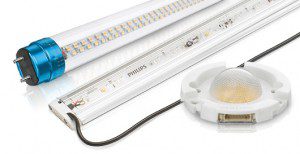
Prototype May Double Energy-Efficiency
LED lighting has long been touted as the “next great thing” in lighting, thanks to the more natural light that consumes less energy to produce. Now, Philips has shown off a new LED prototype that is claimed to be twice as energy efficient as existing LEDs.
The tube-shaped prototype from Philips is capable of 200 lumens per watt, double the 100 lumens per watt typical for conventional strip lighting. Compared to conventional incandescent light bulbs, the energy efficiency of this innovation is even better. Those traditional bulbs typically produce only 15 lumens per watt. The new Philips LED improves upon that by over 1200 percent.
Global Impact In Several Years
Given that estimates of global electricity production devoted to lighting typically range between 15 and 20 percent, this is no small announcement. In the United States alone, if all the existing lighting could suddenly be magically swapped out for these new Philips LEDs, the savings in both dollars and carbon dioxide emissions would be monumental.
Philips suggests such a “swap” would save $12 billion/year and prevent 50-100 million tons of carbon dioxide from being released into the air on an annual basis.
Savings are already being realized as the demise of incandescent lighting has been accelerating. However, fluorescents have been efficient enough that their replacement has been slow to arrive, even given their propensity for that greenish glow many dislike.
2015 Availability Projected
Now, Philips’ new prototype LED, which is expected to be in full production by 2015, promises to change that. Philips’ new LEDs should be twice as efficient as typical fluorescents.
In the lighting industry, when Philips talks, analysts listen. Of the current total estimated global lighting demand of about $85 billion, Philips has over $11 billion of the market, according to consultant McKinsey.
Philips admits that these new LEDs will cost more than the bulbs they replace. The estimated 20-year lifespan also exceeds the still-impressive lifespans of current LED lighting. Those commercial enterprises that use lighting on a 24/7 basis will find the maintenance cost savings over time to be persuasive as well.
At Relumination, we are always alert to developing trends in lighting. Please contact us for ideas on how to reduce your carbon footprint and improve your bottom line.





